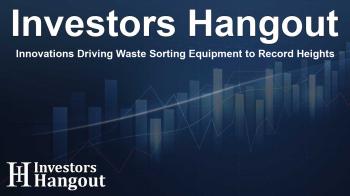Innovations Driving Waste Sorting Equipment to Record Heights

Understanding the Growth of the Waste Sorting Equipment Market
The Waste Sorting Equipment Market is experiencing remarkable growth, projected to reach USD 1585.10 million by 2032, up from USD 963.45 million in 2024. Driven by escalating urbanization and advancements in automation technologies, the market is set to grow at a compound annual growth rate (CAGR) of 6.42% during the forecast period from 2025 to 2032. This growth reflects a broader industry trend towards increased efficiency and sustainability.
Market Dynamics Shaping Future Trends
Smart Technologies and Recycling Initiatives
A significant factor influencing the evolution of the waste sorting equipment market is the stringent recycling targets and landfill reduction policies embraced by many countries. Investments in state-of-the-art, AI-driven waste sorting systems, exemplified by Waste Management, Inc.'s substantial funding initiatives, indicate a pivotal shift in how waste is managed. Countries like Germany and Japan showcase impressive municipal recycling rates, demonstrating the effectiveness of robust recycling policies supported by government initiatives.
The Impact of Urbanization
The increase in urban populations has correspondingly raised the volume of waste generated, which in turn boosts the demand for enhanced waste management solutions. Cities worldwide are facing mounting pressures to adopt efficient sorting technologies that assist in meeting recycling goals and environmental standards. The surge of urbanization also opens doors for manufacturers to innovate new technologies tailored to address challenges associated with waste sorting.
Regional Insights and Market Performance
Key Players Leading the Market
The U.S. waste sorting equipment market, which is anticipated to grow from USD 128.33 million in 2024 to USD 210.01 million by 2032, highlights the importance of investment in technological development as states like California implement stringent environmental policies. Leading players in the market, such as TOMRA Systems ASA and Steinert GmbH, are consistently redefining the landscape by driving adoption of advanced solutions that enhance recycling accuracy and efficiency.
The Role of Municipalities in Equipment Adoption
Public-private partnerships have emerged as a crucial mechanism for accelerating the installation of new waste sorting facilities. As cities seek to comply with sustainability goals, collaborations with waste management companies enhance the infrastructure necessary for effective waste sorting. Investments in materials recovery facilities (MRFs) in urban centers are essential for meeting increasing waste management demands.
Market Attributes and Outlook
Forecasts indicate that by 2032, the waste sorting equipment market will have a significant contribution from sectors like municipal waste management and recycling services. The integration of smart technologies such as sensor-based sorting is expected to dominate, driven by its capability to provide rapid and efficient sorting solutions. Applications focused on plastic waste recovery are particularly notable, considering the rising societal push towards reducing plastic pollution.
Recent Developments in Waste Sorting Technology
Innovations Enhancing Sorting Precision
Recent advancements in the sector, such as TOMRA Recycling's launch of the X-TRACT™ X-ray sorter, exhibit a commitment to improving the efficiency of waste sorting. This innovative technology improves accuracy in separating various waste types, including wood, while reducing overall operational costs. The continual development and introduction of such technologies play a fundamental role in meeting the recycling demands of modern economies.
A Growing Demand for Plastic Sorting Systems
As environmental awareness heightens, the emphasis on effective plastic sorting has surged. Companies are investing heavily in technologies that enable the recovery of high-quality recycled plastics. Initiatives spearheaded by major corporations align closely with public goals, driving the necessity for advanced waste sorting systems that focus on material purity and sustainability.
Frequently Asked Questions
What is the projected growth of the waste sorting equipment market?
The waste sorting equipment market is projected to grow from USD 963.45 million in 2024 to USD 1585.10 million by 2032.
What factors are driving the demand for waste sorting equipment?
Increased urbanization, stringent recycling mandates, and technological innovations are significant driving forces of demand in the waste sorting equipment market.
Which region leads in the waste sorting equipment market?
Europe currently holds the largest market share due to strict recycling regulations and a growing demand for eco-friendly solutions.
What technology is dominating the market?
Sensor-based sorting technologies, due to their efficiency and accuracy, are currently the most prominent in the waste sorting equipment market.
How important are public-private partnerships in this market?
Public-private partnerships play a crucial role in facilitating the development and installation of advanced waste sorting technologies across municipalities.
About The Author
Contact Caleb Price privately here. Or send an email with ATTN: Caleb Price as the subject to contact@investorshangout.com.
About Investors Hangout
Investors Hangout is a leading online stock forum for financial discussion and learning, offering a wide range of free tools and resources. It draws in traders of all levels, who exchange market knowledge, investigate trading tactics, and keep an eye on industry developments in real time. Featuring financial articles, stock message boards, quotes, charts, company profiles, and live news updates. Through cooperative learning and a wealth of informational resources, it helps users from novices creating their first portfolios to experts honing their techniques. Join Investors Hangout today: https://investorshangout.com/
The content of this article is based on factual, publicly available information and does not represent legal, financial, or investment advice. Investors Hangout does not offer financial advice, and the author is not a licensed financial advisor. Consult a qualified advisor before making any financial or investment decisions based on this article. This article should not be considered advice to purchase, sell, or hold any securities or other investments. If any of the material provided here is inaccurate, please contact us for corrections.

